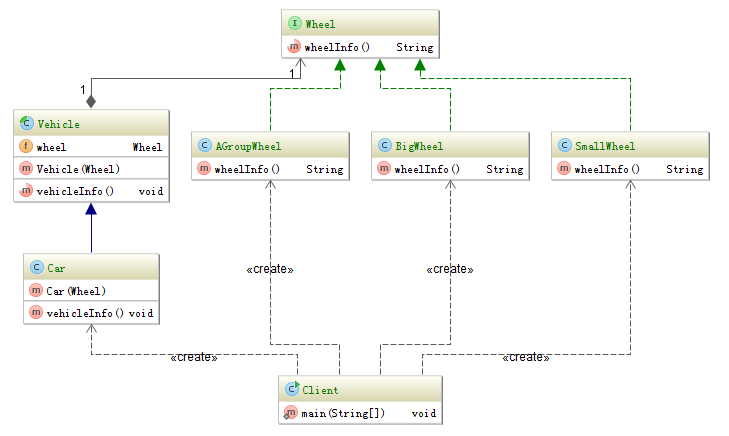Java bridge design pattern example 2016-12-22 08:01
Bridge pattern is useful for add a common property to a series of objects. Let's say we have a series of vehicles; like car and train. Different vehicles has different kind of wheels. It is easy to change wheels of vehicles after making wheel as a property of vehicles.
Sample code is like following.
public abstract class Vehicle {
protected Wheel wheel;
public Vehicle(Wheel wheel) {
this.wheel = wheel;
}
abstract void vehicleInfo();
}
public class Car extends Vehicle {
public Car(Wheel wheel) {
super(wheel);
}
@Override
void vehicleInfo() {
System.out.println("Car with " + wheel.wheelInfo());
}
}
The relation code of Wheel
public interface Wheel {
String wheelInfo();
}
public class SmallWheel implements Wheel {
@Override
public String wheelInfo() {
return "small wheel";
}
}
public class BigWheel implements Wheel {
@Override
public String wheelInfo() {
return "big wheel";
}
}
The code of Client.
public class Client {
public static void main(String[] args) {
Car bigCar = new Car(new BigWheel());
bigCar.vehicleInfo();
Car smallCar = new Car(new SmallWheel());
smallCar.vehicleInfo();
}
}
The output is like following.
Car with big wheel
Car with small wheel
We abstract wheel out as an interface. When there is a new kind of wheel we only need add a class (AGroupWheel). The code of client is like following.
public class Client {
public static void main(String[] args) {
Car bigCar = new Car(new BigWheel());
bigCar.vehicleInfo();
Car smallCar = new Car(new SmallWheel());
smallCar.vehicleInfo();
Car manyWheelCar = new Car(new AGroupWheel());
manyWheelCar.vehicleInfo();
}
}
The output is like following.
Car with big wheel
Car with small wheel
Car with a group of wheels
Summary
The relationship between Wheel and Vehicle is Bridge. Make the part of changing (Wheel) as interface and abstract this part as a property. We only need add a new class (AGroupWheel) when requirements change.
